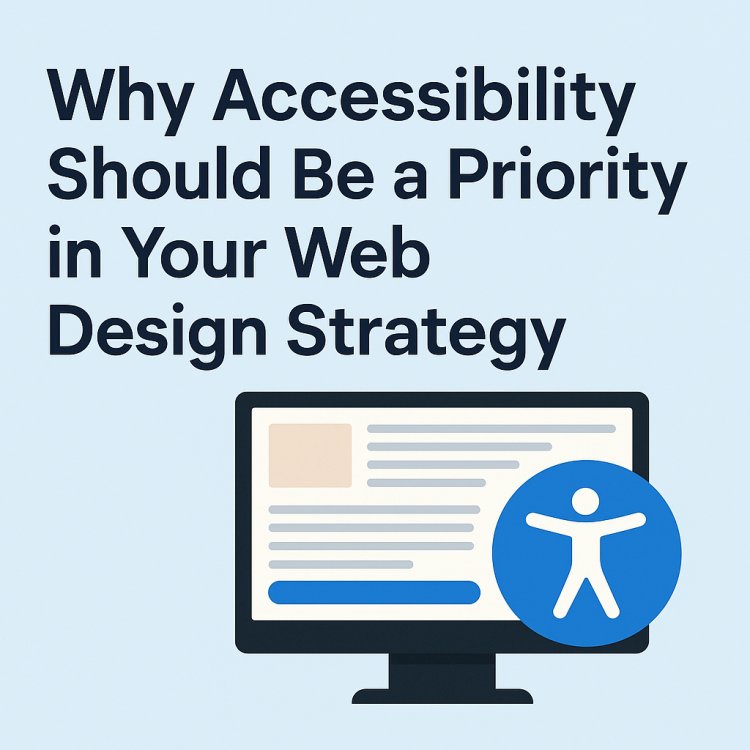Why Accessibility Should Be a Priority in Your Web Design Strategy
In today's digital-first UK economy, an accessible website isn't just good practice—it's good business. With over 14 million people in the UK reporting disabilities and new accessibility regulations coming into force, creating inclusive digital experiences has become essential for any business offering web and mobile app development services or web application development services.

In today's digital-first UK economy, an accessible website isn't just good practice—it's good business. With over 14 million people in the UK reporting disabilities and new accessibility regulations coming into force, creating inclusive digital experiences has become essential for any business offering web and mobile app development services or web application development services.
This comprehensive guide explores why accessibility must be at the heart of your web strategy, how it benefits all users (not just those with disabilities), and provides actionable steps to make your digital presence more inclusive today.
The Current State of Web Accessibility in the UK
Recent statistics reveal why accessibility can't be ignored:
-
1 in 5 UK adults has a disability (Scope)
-
83% of disabled users encounter barriers on websites (WebAIM)
-
£17.1 billion annual spending power of disabled households (Purple Pound)
-
Legal requirements under the Equality Act 2010 and the upcoming Online Safety Bill
For technical services like web application development services, accessibility demonstrates your commitment to building solutions for everyone.
Beyond Compliance: The Business Case for Accessibility
1. Expanded Market Reach
Accessible websites tap into the £17 billion Purple Pound economy—a market segment often overlooked by competitors.
2. Improved SEO Performance
Many accessibility practices align perfectly with SEO best practices:
-
Semantic HTML structure helps search engines understand content
-
Proper heading hierarchy improves content organization
-
Text alternatives for images boost keyword relevance
3. Enhanced User Experience for All
Accessibility features like:
-
Clear navigation benefits elderly users
-
Captions help in noisy environments
-
Keyboard controls assist power users
4. Reduced Legal Risk
With accessibility-related lawsuits increasing globally, proactive compliance protects your business.
The Web Content Accessibility Guidelines (WCAG) Explained
The internationally recognized WCAG 2.1 standards focus on four principles:
1. Perceivable
-
Text alternatives for non-text content
-
Captions and other alternatives for multimedia
-
Content that can be presented in different ways
2. Operable
-
Keyboard accessible functionality
-
Enough time to read and use content
-
Content that doesn't cause seizures
3. Understandable
-
Readable and predictable text
-
Input assistance for forms
4. Robust
-
Compatibility with current and future tools
Common Accessibility Barriers (And How to Fix Them)
1. Poor Color Contrast
Solution: Ensure minimum 4.5:1 contrast ratio (AA standard)
Tool: WebAIM Contrast Checker
2. Missing Alt Text
Solution: Add descriptive alt text to all meaningful images
Example: "Team meeting about web accessibility best practices" instead of "team-photo.jpg"
3. Keyboard Traps
Solution: Ensure all functionality available via keyboard
Test: Try navigating your site using only the Tab key
4. Unlabeled Form Elements
Solution: Associate all form fields with visible labels
Bonus: Add helpful error messages
Accessibility Success Stories from UK Businesses
Case Study 1: BBC
The BBC's accessibility initiatives led to:
-
30% increase in disabled user engagement
-
Improved search rankings for educational content
-
Industry recognition as accessibility leaders
Case Study 2: Barclays
Barclays' accessible online banking:
-
Reduced customer service calls by 22%
-
Improved satisfaction across all user groups
-
Won multiple accessibility awards
Step-by-Step Accessibility Implementation
1. Conduct an Accessibility Audit
-
Automated tools like WAVE or axe
-
Manual testing with screen readers
-
User testing with disabled participants
2. Prioritize Fixes by Impact
-
Start with critical navigation issues
-
Address major WCAG failures
-
Then refine smaller enhancements
3. Develop an Accessibility Policy
Document your:
-
Commitment to accessibility
-
Roadmap for improvements
-
Contact method for accessibility feedback
4. Train Your Team
Ensure all staff understand:
-
Basic accessibility principles
-
How to create accessible content
-
Testing methodologies
Technical Considerations for Developers
For businesses offering web and mobile app development services, these technical practices are essential:
1. Semantic HTML
-
Proper use of heading hierarchy
-
Landmark roles (header, nav, main, footer)
-
ARIA attributes where needed
2. Accessible Interactive Elements
-
Focus states for keyboard users
-
Sufficient hit areas for touch targets
-
Accessible modal dialogs
3. Responsive Design
-
Flexible layouts that work at all zoom levels
-
Content that reflows without horizontal scrolling
The ROI of Accessibility
Investing in accessibility delivers measurable returns:
-
20-30% wider audience reach
-
15-25% improved SEO performance
-
Reduced maintenance costs (cleaner code)
-
Enhanced brand reputation
For web application development services, accessibility becomes a competitive differentiator in procurement processes.
Overcoming Common Accessibility Myths
Myth: "Accessibility is only for blind users"
Truth: Benefits include elderly users, those with temporary impairments, and even users in challenging environments
Myth: "Accessible sites are ugly"
Truth: Great design and accessibility complement each other
Myth: "It's too expensive to implement"
Truth: Building in accessibility from the start adds minimal cost
Tools and Resources for Ongoing Accessibility
-
WAVE Evaluation Tool (Browser extension)
-
NVDA Screen Reader (Free testing tool)
-
Color Oracle (Color blindness simulator)
-
WebAIM Checklist (WCAG quick reference)
Measuring Accessibility Success
Track these key metrics:
-
WCAG compliance level (A, AA, AAA)
-
Assistive technology compatibility
-
User feedback from disabled visitors
-
Search ranking improvements
The Future of Accessibility in the UK
With upcoming regulations and growing consumer expectations, accessibility will soon be:
-
Required for all public sector websites
-
A ranking factor in search algorithms
-
A standard requirement in procurement
Businesses that act now will gain first-mover advantage.
Ready to Make Accessibility a Priority?
Creating an inclusive digital presence isn't just the right thing to do—it's smart business strategy. Whether you provide web and mobile app development services or other digital solutions, accessibility should be at the heart of your web design approach.
At Pure Website Design, we specialize in building beautiful, accessible websites that work for everyone. Start your accessibility journey today with our free compliance audit—we'll identify exactly where your site meets standards and where improvements can open your business to new audiences.
Don't exclude potential customers through avoidable accessibility barriers. Implement these strategies now to future-proof your digital presence and demonstrate your commitment to inclusive design. Your most valuable users are waiting—make sure they can access what you offer.
What's Your Reaction?

















.jpg)
